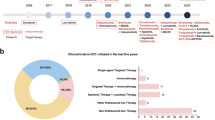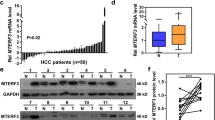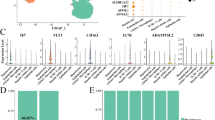Abstract
Aim:
Telekin, isolated from the Chinese herb Carpesium divaricatum, has shown anti-proliferation effects against various cancer cells, including hepatocellular carcinoma cells. In this study, we investigated the anti-proliferation mechanisms of telekin in human hepatocellular carcinoma HepG2 cells in vitro.
Methods:
HepG2 cells were treated with telekin. Cell viability was evaluated using MTT assay. Flow cytometry was used to measure cell cycle profiles, ROS level and apoptosis. The protein expression levels were analyzed with Western blotting.
Results:
Telekin (3.75–30 μmol/L) dose-dependently inhibited the viability of HepG2 cells and induced l apoptosis. Furthermore, the treatment induced cell cycle arrest at G2/M phase, accompanied by significantly increased the phosphorylation of Cdc25A and Cdc2, and decreased Cyclin B1 level. Moreover, the treatment significantly stimulated ROS production, and increased the phosphorylation of p38 and MAPKAPK-2 in the cells. Pretreatment with the antioxidant NAC (2.5, 5, and 10 mmol/L), or the p38 MAPK inhibitor SB203580 (2.5 and 5 μmol/L) dose-dependently attenuated these telekin-induced effects in the cells.
Conclusion:
Telekin suppresses hepatocellular carcinoma cells in vitro by inducing G2/M phase arrest via activating the p38 MAPK pathway.
Similar content being viewed by others
Log in or create a free account to read this content
Gain free access to this article, as well as selected content from this journal and more on nature.com
or
References
Zheng SE, Xiong S, Lin F, Qiao GL, Feng T, Shen Z, et al. Pirarubicin inhibits multidrug-resistant osteosarcoma cell proliferation through induction of G2/M phase cell cycle arrest. Acta Pharmacol Sin 2012; 33: 832–8.
Wang HC, Chung PJ, Wu CH, Lan KP, Yang MY, Wang CJ, et al. Polyphenolic extract inhibits hepatocarcinoma cell growth by inducing G2/M phase arrest and apoptosis. J Sci Food Agric 2011; 91: 178–85.
Choi YH, Lee WH, Park KY, Zhang L . p53-independent induction of p21 (WAF1/CIP1), reduction of cyclin B1 and G2/M arrest by the isoflavone genistein in human prostate carcinoma cells. Jpn J Cancer Res 2000; 91: 164–73.
Hartwell LH, Kastan MB . Cell cycle control and cancer. Science 1994; 266: 1821–8.
Khaled AR, Bulavin DV, Kittipatarin C, Li WQ, Alvarez M, Kim K, et al. Cytokine-driven cell cycling is mediated through Cdc25A. J Cell Biol 2005; 169: 755–63.
Shen T, Huang S . The role of Cdc25A in the regulation of cell proliferation and apoptosis. Anticancer Agents Med Chem 2012; 12: 631–9.
Karlsson-Rosenthal C, Millar JB . Cdc25: mechanisms of checkpoint inhibition and recovery. Trends Cell Biol 2006; 16: 285–92.
Boutros R, Dozier C, Ducommun B . The when and wheres of CDC25 phosphatases. Curr Opin Cell Biol 2006; 18: 185–91.
Takenaka K, Moriguchi T, Nishida E . Activation of the protein kinase p38 in the spindle assembly checkpoint and mitotic arrest. Science 1998; 280: 599–602.
Johnson GL, Lapadat R . Mitogen-activated protein kinase pathways mediated by ERK, JNK, and p38 protein kinases. Science 2002; 298: 1911–2.
Jin S, Tong T, Fan W, Fan F, Antinore MJ, Zhu X, et al. GADD45-induced cell cycle G2-M arrest associates with altered subcellular distribution of cyclin B1 and is independent of p38 kinase activity. Oncogene 2002; 21: 8696–704.
Martin-Blanco E . p38 MAPK signalling cascades: ancient roles and new functions. Bioessays 2000; 22: 637–45.
Bulavin DV, Higashimoto Y, Popoff IJ, Gaarde WA, Basrur V, Potapova O, et al. Initiation of a G2/M checkpoint after ultraviolet radiation requires p38 kinase. Nature 2001; 411: 102–7.
Ding XL, Husseman J, Tomashevski A, Nochlin D, Jin LW, Vincent I . The cell cycle Cdc25A tyrosine phosphatase is activated in degenerating postmitotic neurons in Alzheimer's disease. Am J Pathol 2000; 157: 1983–90.
Goloudina A, Yamaguchi H, Chervyakova DB, Appella E, Fornace AJ Jr, Bulavin DV . Regulation of human Cdc25A stability by Serine 75 phosphorylation is not sufficient to activate a S phase checkpoint. Cell Cycle 2003; 2: 473–8.
Efferth T . Cancer therapy with natural products and medicinal plants. Planta Med 2010; 76: 1035–6.
Paukku Y, Rasulev B, Syrov V, Khushbaktova Z, Leszczynski J . Structure-hepatoprotective activity relationship study of sesquiterpene lactones: A QSAR analysis. Int J Quantum Chem 2009; 109: 17–27.
Li XW, Weng L, Gao X, Zhao Y, Pang F, Liu JH, et al. Antiproliferative and apoptotic sesquiterpene lactones from Carpesium faberi. Bioorg Med Chem Lett 2011; 21: 366–72.
Lee J, Min B, Lee S, Na M, Kwon B, Lee C, et al. Cytotoxic sesquiterpene lactones from Carpesium abrotanoides. Planta Med 2002; 68: 745–7.
Zheng B, Wu L, Ma L, Liu S, Li L, Xie W, et al. Telekin induces apoptosis associated with the mitochondria-mediated pathway in human hepatocellular carcinoma cells. Biol Pharm Bull 2013; 36: 1118–25.
Xie WD, Wang XR, Ma LS, Li X, Row KH . Sesquiterpenoids from Carpesium divaricatum and their cytotoxic activity. Fitoterapia 2012; 83: 1351–5.
Kumar S, Jiang MS, Adams JL, Lee JC . Pyridinylimidazole compound SB 203580 inhibits the activity but not the activation of p38 mitogen-activated protein kinase. Biochem Biophys Res Commun 1999; 263: 825–31.
Clerk A, Sugden PH . The p38-MAPK inhibitor, SB203580, inhibits cardiac stress-activated protein kinases/c-Jun N-terminal kinases (SAPKs/JNKs). FEBS Lett 1998; 426: 93–6.
Shi X, Zhou B . The role of Nrf2 and MAPK pathways in PFOS-induced oxidative stress in zebrafish embryos. Toxicol Sci 2010; 115: 391–400.
Zafarullah M, Li WQ, Sylvester J, Ahmad M . Molecular mechanisms of N-acetylcysteine actions. Cell Mol Life Sci 2003; 60: 6–20.
Hamada S, Fujita S . DAPI staining improved for quantitative cytofluorometry. Histochemistry 1983; 79: 219–26.
Coleman AW, Maguire MJ, Coleman JR . Mithramycin- and 4′-6-diamidino-2-phenylindole (DAPI)-DNA staining for fluorescence microspectrophotometric measurement of DNA in nuclei, plastids, and virus particles. J Histochem Cytochem 1981; 29: 959–68.
Innocente SA, Abrahamson JL, Cogswell JP, Lee JM . p53 regulates a G2 checkpoint through cyclin B1. Proc Natl Acad Sci U S A 1999; 96: 2147–52.
Liu SS, Wang YF, Ma LS, Zheng BB, Li L, Xie WD, et al. 1-Oxoeudesm-11(13)-eno-12,8a-lactone induces G2/M arrest and apoptosis of human glioblastoma cells in vitro. Acta Pharmacol Sin 2013; 34: 271–81.
Lin CC, Lin SY, Chung JG, Lin JP, Chen GW, Kao ST . Down-regulation of cyclin B1 and up-regulation of Wee1 by berberine promotes entry of leukemia cells into the G2/M-phase of the cell cycle. Anticancer Res 2006; 26: 1097–104.
Qanungo S, Wang M, Nieminen AL . N-acetyl-L-cysteine enhances apoptosis through inhibition of nuclear factor-kappaB in hypoxic murine embryonic fibroblasts. J Biol Chem 2004; 279: 50455–64.
Liao QC, Xiao ZS, Qin YF, Zhou HH . Genistein stimulates osteoblastic differentiation via p38 MAPK-Cbfa1 pathway in bone marrow culture. Acta Pharmacol Sin 2007; 28: 1597–602.
Chen JT, Fong YC, Li TM, Liu JF, Hsu CW, Chang CS, et al. DDTD, an isoflavone derivative, induces cell apoptosis through the reactive oxygen species/apoptosis signal-regulating kinase 1 pathway in human osteosarcoma cells. Eur J Pharmacol 2008; 597: 19–26.
Kumar S, McDonnell PC, Gum RJ, Hand AT, Lee JC, Young PR . Novel homologues of CSBP/p38 MAP kinase: activation, substrate specificity and sensitivity to inhibition by pyridinyl imidazoles. Biochem Biophys Res Commun 1997; 235: 533–8.
Lee JC, Kassis S, Kumar S, Badger A, Adams JL . p38 mitogen-activated protein kinase inhibitors — mechanisms and therapeutic potentials. Pharmacol Ther 1999; 82: 389–97.
Kulisz A, Chen N, Chandel NS, Shao Z, Schumacker PT . Mitochondrial ROS initiate phosphorylation of p38 MAP kinase during hypoxia in cardiomyocytes. Am J Physiol Lung Cell Mol Physiol 2002; 282: L1324–9.
Wuyts WA, Vanaudenaerde BM, Dupont LJ, Demedts MG, Verleden GM . N-acetylcysteine reduces chemokine release via inhibition of p38 MAPK in human airway smooth muscle cells. Eur Respir J 2003; 22: 43–9.
Olson JM, Hallahan AR . p38 MAP kinase: a convergence point in cancer therapy. Trends Mol Med 2004; 10: 125–9.
Hsu YL, Kuo PL, Lin LT, Lin CC . Asiatic acid, a triterpene, induces apoptosis and cell cycle arrest through activation of extracellular signal-regulated kinase and p38 mitogen-activated protein kinase pathways in human breast cancer cells. J Pharmacol Exp Ther 2005; 313: 333–44.
Jin Y, Fan Y, Yan EZ, Liu Z, Zong ZH, Qi ZM . Effects of sodium ferulate on amyloid-beta-induced MKK3/MKK6-p38 MAPK-Hsp27 signal pathway and apoptosis in rat hippocampus. Acta Pharmacol Sin 2006; 27: 1309–16.
Rane MJ, Coxon PY, Powell DW, Webster R, Klein JB, Pierce W, et al. p38 Kinase-dependent MAPKAPK-2 activation functions as 3-phosphoinositide-dependent kinase-2 for Akt in human neutrophils. J Biol Chem 2001; 276: 3517–23.
Hutchins JR, Clarke PR . Many fingers on the mitotic trigger: post-translational regulation of the Cdc25C phosphatase. Cell Cycle 2004; 3: 41–5.
Margolis SS, Perry JA, Weitzel DH, Freel CD, Yoshida M, Haystead TA, et al. A role for PP1 in the Cdc2/Cyclin B-mediated positive feedback activation of Cdc25. Mol Biol Cell 2006; 17: 1779–89.
Acknowledgements
This work was supported by grants from the National Natural Science Foundation of China (No 81273532).Author contribution Prof Xia LI designed the research and revised the manuscript; Lin LI and Bei-bei ZHENG conducted the research, analyzed the data, and wrote the paper; Li-sha MA, Xiao SUN, Juan-juan CHANG, and Wei-dong XIE helped with portions of the research.
Author information
Authors and Affiliations
Corresponding author
Rights and permissions
About this article
Cite this article
Li, L., Zheng, Bb., Ma, Ls. et al. Telekin suppresses human hepatocellular carcinoma cells in vitro by inducing G2/M phase arrest via the p38 MAPK signaling pathway. Acta Pharmacol Sin 35, 1311–1322 (2014). https://doi.org/10.1038/aps.2014.74
Received:
Accepted:
Published:
Issue date:
DOI: https://doi.org/10.1038/aps.2014.74
Keywords
This article is cited by
-
Toxicarioside N induces apoptosis in human gastric cancer SGC-7901 cell by activating the p38MAPK pathway
Archives of Pharmacal Research (2018)
-
New benzimidazole acridine derivative induces human colon cancer cell apoptosis in vitro via the ROS-JNK signaling pathway
Acta Pharmacologica Sinica (2015)



